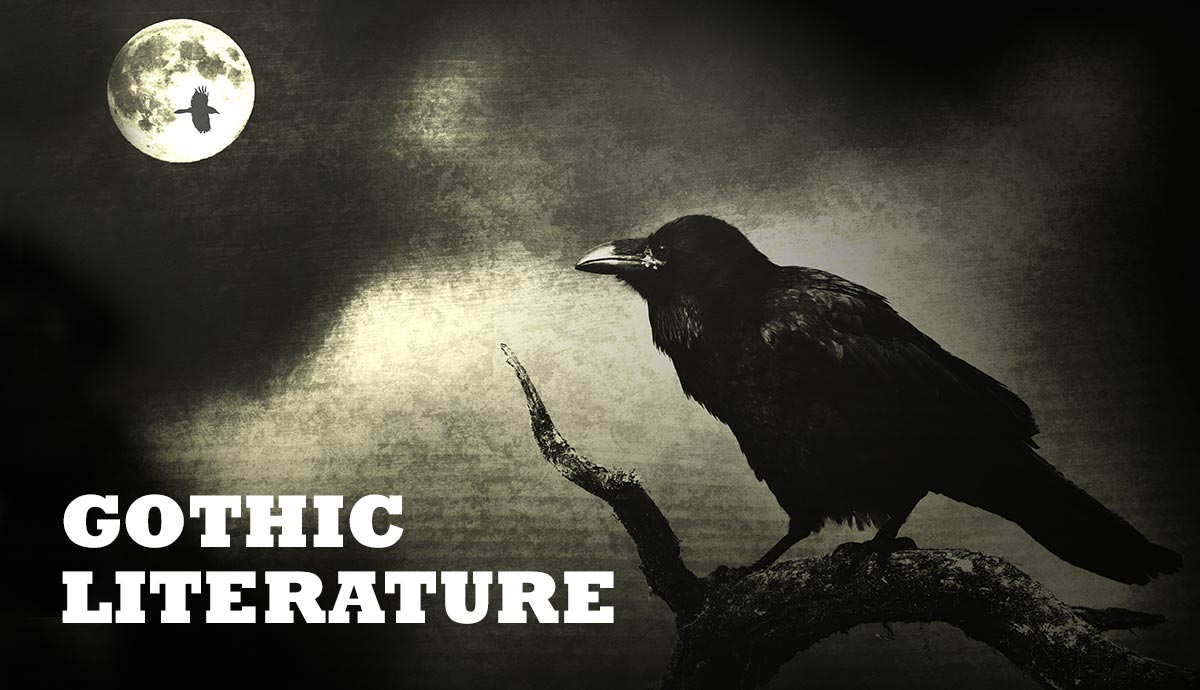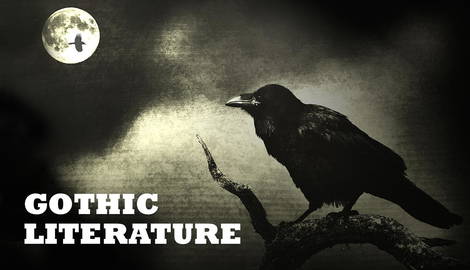
Gothic literature is a popular and enduring genre. The influence in today’s culture can be seen in the popularity of horror, ghost stories and vampire romances. However, the original writers of Gothic literature drew their inspiration from an eclectic range of sources. The development of the genre also coincides with cultural, social and scientific developments in history. Gothic novels have produced some of the most iconic characters and settings in Western literature.
What Are the Origins of the Term “Gothic”?

Gothic literature has a diverse range of influences and characteristics. The term “Gothic” comes from the style of architecture with the same name. Characterized by elaborate stonework, arched windows and flying buttresses, Gothic architecture was popular in Europe between the 12th and 16th centuries. The architectural style later often featured as a setting in Gothic novels, hence the genre’s name.
Why Gothic literature blossomed in the late 18th century is perhaps difficult to determine. There are certainly suggestions that it was borne from the ideals of Romanticism, an artistic movement which reacted against the rationalism of the earlier Enlightenment period. Some academics theorize that people wanted to read works that would fulfill a sense of wonder and the unexplained. Many Gothic novels explore the tension between rationality or science and religion or superstition.
Furthermore, Shakespeare and Milton’s works have retrospectively been described as Gothic (perhaps to lend credibility to the genre, which was often maligned by critics). Another influence can be found in the political upheaval that preceded the Gothic novel including the English Civil War of the 17th century and the Jacobite Rebellion of 1745.
Key Features of the Gothic Genre

As with any literary genre, the definition has evolved over time and often overlaps with other genres including romance, horror and historical fiction. That being said, a typical work of Gothic literature will be characterized by taking place in a gloomy setting (including Gothic castles, graveyards, and abandoned houses). The landscapes are frequently barren, desolate and isolating (borrowing from Romantic ideals of the sublime). Weather is also a crucial part of setting the tone, with many Gothic authors making use of pathetic fallacy to underscore their plot.
Stereotypical characters found in Gothic literature include gendered stereotypes such as passive, innocent females and virtuous heroes. The supernatural is often personified as a creature such as a vampire, ghost or witch. Early examples of Gothic literature were often deemed melodramatic and lacking in psychological depth, however this has developed over time with new advances in psychology influencing characterisation.
The plots of Gothic novels often work to uncover a mystery (either manmade or, more frequently, supernatural). Common plot devices include romance, preoccupation with death, supernatural, good vs evil and innocent victims. Gothic novels have often been presented in an epistolary form to give the appearance of legitimate historical record. This echoes again the contrast between rational, scientific understanding and the more esoteric, emotionally-driven Romantic movement.
What Was the First Gothic Novel?

Considered the first Gothic novel in the English language, The Castle of Otranto by Horace Walpole also founded literary horror as a legitimate genre. It was published in 1764, but the story was set in an imagined medieval past. Walpole gives the novel the appearance of it being a genuine historical artefact by including a preface stating that the text is a newly-discovered manuscript written sometime between 1095 and 1243. The plot involves ghosts, damsels in distress, visions, prophecies and the story takes place in the gloomy Castle of Otranto, located in Southern Italy. The Castle of Otranto also bears a resemblance to Shakespeare’s Hamlet (1623).
Walpole was a keen enthusiast of Gothic architecture and a history scholar to boot. His two interests seem to have inspired him to create this archetype of Gothic literature. In fact, Walpole subtitled his work “A Gothic Story,” thus giving this popular new genre its name. Although the novel received mixed reviews, it sold very well and influenced a slew of other works including Ann Radcliffe’s The Mystery of Udolpho (1794) and Matthew Lewis’s The Monk (1796).
Parodies of the Gothic Genre

The popularity of the Gothic genre and its dramatic excesses made it a target for satire. Capitalizing on public enthusiasm for the novel form in the late 18th century, many authors worked quickly to produce their own Gothic works. Furthermore, cheap imitators produced “chapbooks” (small pamphlets) leading to the popularity of so-called “Penny Dreadfuls” in the 19th century. These cheaply produced pamphlets featured the more sensationalist elements of Gothic fiction, leaning heavily into the gore and horror.
The genre’s tone and characters were familiar enough with contemporary readers for Jane Austen to parody the Gothic style in Northanger Abbey (1818). Catherine Morland, the heroine of this novel, is an avid fan of Gothic novels and has become so infatuated with the genre that she imagines villainy and mystery all around her. She also finds friends and potential suitors equally gripped by Gothic novel reading. The text is also an interesting example of the genre as it includes a list of novels recommended to Catherine, dubbed the “Northanger ‘Horrid’ novels.” With titles including The Midnight Bell and The Necromancer, these were once considered to be Austen’s own creations until researchers in the 1920s discovered they really existed. Their mistake was an understandable one; in the late 1700s and early 1800s there were more parodies of Gothic literature published than serious Gothic novels, including the memorably titled More Ghosts! (1798).
A Key Turning Point in the Development of Gothic Literature

If there can be said to be one defining event in the history of Gothic literature, then Lord Byron’s infamous ghost story competition on the banks of Lake Geneva is surely it. The anecdote itself has all the ingredients of a Gothic tale. In 1816, Lord Byron settled in Villa Diodati on the shore of Lake Geneva. He had fled England after a series of scandals and followed the Grand Tour—a popular tourist route amongst the English upper classes—across mainland Europe.
His companions included his doctor William Polidori, the poet Percy Bysshe Shelley, Shelley’s future wife Mary Godwin, and her stepsister Claire Claremont. These young, Romantic figures had attracted some scandal as Claremont and Byron shared an illegitimate daughter and Shelley and Godwin were not yet married, despite traveling freely together.
Sheltering in the villa for three days to avoid torrential rain, Byron set the group a challenge to create a ghost story. It was here that Mary Godwin created the iconic Gothic work Frankenstein (1818). At just 18 years old, Mary Godwin (later Shelley) created a seminal work of Gothic literature which features the tortured Victor Frankenstein pursued by his monstrous creation.
Although this is the most famous work to come from this event, another influential work was also inspired by the fireside ghost stories: Polodori’s The Vampyre (1819). This novel is a seminal work in our cultural understanding of vampire lore. Bram Stoker drew inspiration from The Vampyre while writing his own classic novel Dracula (1897).

Furthermore, Lord Byron’s literary reputation became so influential that his name is given to a classic archetype of Gothic fiction known as “the Byronic hero.” This figure is a key player in later Gothic works such as those by the Brontë sisters. The Byronic hero is characterized by his brooding, emotionally complex demeanor as well as a dangerous sexuality and arrogance.
Victorian Gothic Literature

The Victorian era is when Gothic literature blossomed. The genre became more nuanced and expanded its focus to include some of the social and psychological concerns of the age. The novels of the Brontë Sisters are great examples of the Gothic genre in this era. From Jane Eyre (1847) and its brooding character Edward Rochester, an archetypal Byronic Hero, to the wild landscape and isolated country houses in Emily Brontë’s Wuthering Heights (1847).
Some of the most iconic characters and settings found in the novels of Wilkie Collins, Charles Dickens and Sir Walter Scott can be described as Gothic (none more so than the jilted, haunted Miss Havisham in Great Expectations [1861]). However, these novels often transcend the genre and experiment with blending other genres such as detective fiction, historical fiction and romance.

This era also saw the creation of two of the most iconic Gothic creatures. Stoker’s Dracula built on Polidori’s tale to popularize vampire fiction. Meanwhile, Robert Louis Stevenson wrote Dr Jekyll and Mr Hyde (1886) in the style of a Gothic novel but was also influenced by religious, medical and psychological developments of the age.

However, the most influential examples of Gothic literature during this era are now considered luminaries of Gothic horror with ghost stories at the heart of many. Edgar Allan Poe and MR James created volumes of macabre tales which often took place in Gothic settings. In addition, MR James created the template for ghost stories that have endured to today.











